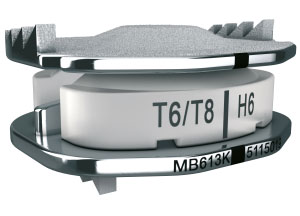
Five-year clinical results have shown cervical total disc replacement to offer a superior alternative to anterior discectomy and fusion for treatment of two-level symptomatic degenerative disc disease. The data have been published by the Journal of Neurosurgery: Spine.
Based on the US Food and Drug Administration composite outcome measure for success, the overall success rates at five years were 61% and 31% for the cTDR and ACDF groups, respectively (p<0.0001). The significantly higher overall success rate for the cTDR group meets superiority and non-inferiority criteria.
The paper, which used the Mobi-C disc (LDR), provided statistically significant greater improvement in general and disease specific outcome measures compared to anterior cervical discectomy and fusion (ACDF). Additionally, there was a lower incidence of index level and adjacent level reoperation with cervical total disc replacement (cTDR).
The authors noted that the five-year follow-up rates for both groups (90.7% for cTDR and 86.7% for ACDF) are comparable to or higher than those reported in other long-term randomised control trials of cervical arthroplasty, and enable adequate statistical power to test both non-inferiority and superiority. The Mobi-C patients had a statistically significant greater improvement than ACDF patients in Neck Disability Index (NDI) score, Short Form Health Survey–Physical Component Score (SF-12 PCS), and overall satisfaction with treatment at 60 months.
Five-year outcomes cTDR ACDF:
Rate of overall secondary surgeries: 7% (cTDR) 21% (ACDF) p=0.0006
Neck Disability Index (NDI) improvement -37 (cTDR) -28 (ACDF) p=0.0003
Rate of adjacent segment degeneration at the superior level: 32.6% cTDR 70.8% (ACDF) p<0.0001
Rate of adjacent segment degeneration at the inferior level: 22.4% (cTDR) 55.1% (ACDF) p<0.0001
Composite overall success: 61% (cTDR) 31% (ACDF) p<0.0001
Christophe Lavigne, president and chief executive officer of LDR, comments, “For the first time in the history of spinal medicine, clinical evidence of two-level cervical disc replacement outcomes, out to five years, has been peer-reviewed and published, and the findings are very encouraging. Two-level cervical total disc replacement has been proven as a safe and effective treatment with statistical superiority in overall outcome as compared to the previous gold standard of treatment, ACDF.
“Although both ACDF and cTDR satisfactorily treat clinically symptomatic cervical pathology, arthrodesis alters cervical mechanics placing increased stresses on adjacent segments, which may contribute to the development of symptomatic degeneration at those adjacent levels. By preserving the motion of the operated segment, cTDR places comparatively less stresses on adjacent levels which may serve to protect those levels.”













